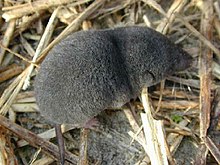Soricidae
| Shrews Temporal range: Middle Eocene–Recent |
|
|---|---|
 |
|
| A southern short-tailed shrew | |
| Scientific classification | |
| Kingdom: | Animalia |
| Phylum: | Chordata |
| Class: | Mammalia |
| Infraclass: | Eutheria |
| Order: | Eulipotyphla |
| Family: |
Soricidae G. Fischer, 1814 |
| Subfamilies | |
A shrew or shrew mouse (family Soricidae) is a small mole-like mammal classified in the order Eulipotyphla. True shrews are also not to be confused with West Indies shrews, treeshrews, otter shrews, or elephant shrews, which belong to different families or orders.
Although its external appearance is generally that of a long-nosed mouse, a shrew is not a rodent, as mice are. It is in fact a much closer relative of moles, and related to rodents only in that both belong to the Boreoeutheria Magnorder. Shrews have sharp, spike-like teeth, not the familiar gnawing front incisor teeth of rodents.
Shrews are distributed almost worldwide: of the major tropical and temperate land masses, only New Guinea, Australia, and New Zealand do not have any native shrews; in South America, shrews are relatively recent immigrants and are present only in the northern Andes. In terms of species diversity, the shrew family is the fourth most successful mammal family, being rivalled only by the muroid rodent families Muridae and Cricetidae and the bat family Vespertilionidae.
All shrews are comparatively small, most no larger than a mouse. The largest species is the Asian house shrew (Suncus murinus) of tropical Asia, which is about 15 cm long and weighs around 100 g; several are very small, notably the Etruscan shrew (Suncus etruscus), which at about 3.5 cm (1.4 in) and 2 g (0.071 oz) is the smallest living terrestrial mammal.
...
Wikipedia
